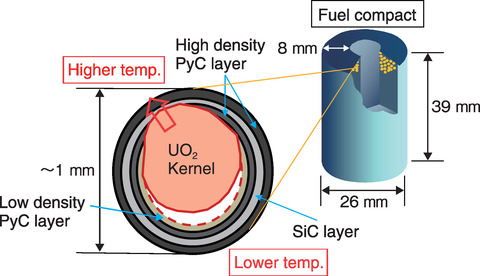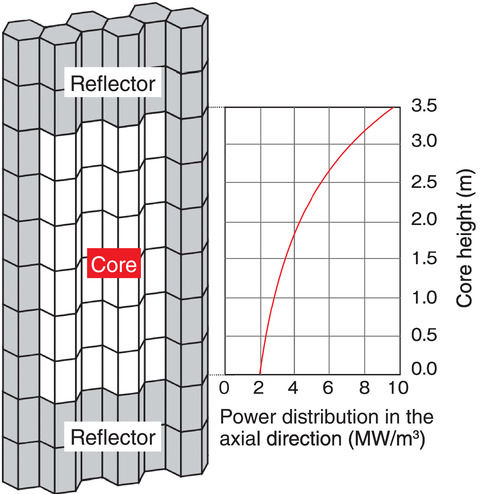
Fig.6-4 Kernel migration mechanism

Fig.6-5 Ideal power distribution minimizing the kernel migration rate
Coated fuel particles (CFPs) are used in high temperature gas-cooled reactors (HTGRs). They consist of a uranium dioxide (UO2) kernel coated with multiple layers of pyrolytic carbon and silicon carbide. This coating layer retains the fission products (FPs) within the CFPs. Kernel migration is known as one of the major CFP failure modes for impairing this FP retention function of the coating layer (Fig.6-4). The kernel migration magnitude is evaluated as an integral of the kernel migration rate (KMR) with respect to time. Therefore, to maintain the CFP integrity from the viewpoint of weakening kernel migration and further improve the burnup in the future, the reactor must be designed such that the KMR is reduced as much as possible. However, the nuclear design policy to maintain the CFP integrity in terms of weakening kernel migration has not been explicitly proposed before. Therefore, we first focus herein on the condition of the ideal power distribution that minimizes the KMR. If the conditions for such an ideal power distribution can be clarified, an actual power distribution can be brought closer to the ideal power distribution by optimizing the arrangement of the fuel enrichment.
The ideal power distribution that minimizes the KMR can be expressed as the power distribution that realizes the state where the KMR maximum value is the smallest. First, by utilizing the Lagrange undecided multiplier method, the ideal power distribution that minimizes the KMR can be realized when the KMR distribution takes a constant value (i.e., when the KMR distribution becomes flat). Second, we developed a numerical method to gradually flatten the KMR distribution by iteratively updating the power distribution because it was difficult to analytically determine the shape of the ideal power distribution due to the complexity of the equations to be solved.
After the abovementioned procedure, we obtained the power distribution that flattened the KMR distribution in the axial direction (Fig.6-5). This allowed us to derive the ideal power distribution to minimize the KMR and propose a nuclear design policy to maintain the CFP integrity (e.g., optimization of the fuel enrichment arrangement from the viewpoint of weakening kernel migration). In the future, we will work on the design study of a commercial HTGR with a long-term burnup by optimizing the fuel enrichment arrangement, reflecting the findings of this study.
(Shoichiro Okita)